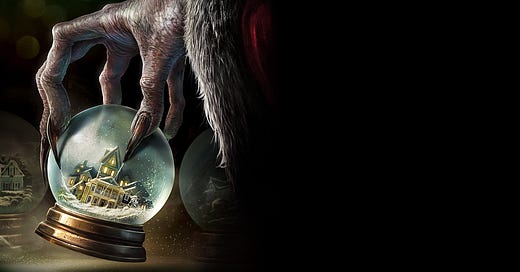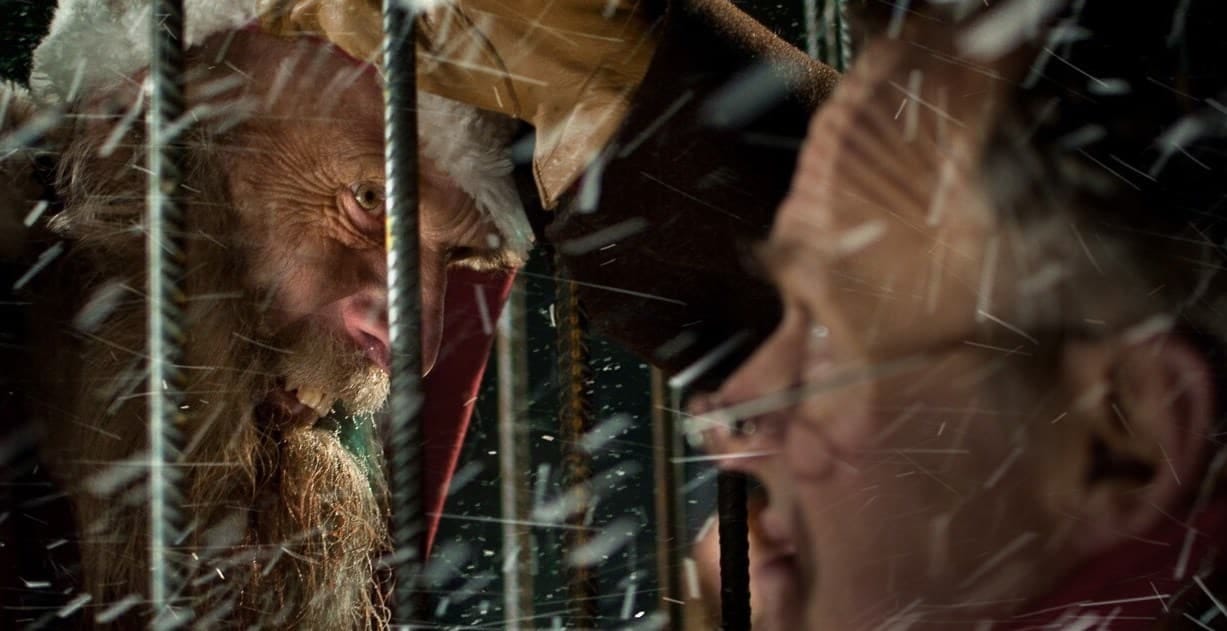My original plan for this miniseries was to look at movies that provided more traditional takes on Santa Claus. But after Santa Claus: The Movie, I realized that might lead to some regret or to tackling movies that have been written about thousands of times, like Miracle on 34th Street. While there are some great Santa movies out there – Netflix is home to the best, Klaus, as well as the perfectly fun The Christmas Chronicles – I wanted to add some variety to my Santa movies. So, this week and next, we’re looking at some more out there takes on Kris Kringle.
Both of this week’s movies look at the Santa legend through a darker lens – and only one actually features Santa. Krampus is focused on the titular mythological character, described as the “shadow of Saint Nicholas,” but it’s so entrenched in holiday aesthetics and the symbols of the season that it counts. Rare Exports, a Finnish fantasy-horror from 2010, features Santa, but with a Krampus-like twist: this isn’t the jolly old elf but a child-punishing beast with an army of elves ready to snatch kids.
And both movies are about how Americans have screwed up the most wonderful time of the year.
Michael Doughtery’s Krampus opens with slow-motion shots of shoppers rioting the day before Christmas, lingering on angry consumers punching each other over electronics and overzealous security guards tasering the out-of-control hordes. The violence soon erupts into a Christmas pageant, where young Max (Emjay Anthony) is involved in a fistfight at the manger, pulled away by his embarrassed parents (Adam Scott and Toni Collette). Max is frustrated; Mom and Dad are going through a rough patch, he’s no longer close with his sister, and he’s losing his belief in Santa. Only his German grandmother seems to understand him. Things don’t get better when his oafish, right-wing aunt and uncle (Allison Tolman and David Koechner) show up with their brood of bullies, a bulldog, and an aunt (Conchata Ferrell) who criticizes everything and everyone. When Max has enough and rips up his heartfelt letter to Santa, a blizzard envelopes the neighborhood and a horned mythological beast begins stalking the rooftops.
Dougherty proved himself a master of holiday horror with his cult Halloween anthology, Trick-R-Treat. That film was saturated in the look of the season, reveling in its witches, werewolves and jack-o-lanterns made from little kids’ heads. It was a fun, scary and atmospheric entry to the horror canon, and its anthology nature meant the stories got in and out before they had a chance to drag.
Krampus suffers a bit from focusing on one story; the pacing plods in the film’s first half, and Dougherty struggles with tone. The film initially feels like a more sharp-edged National Lampoon’s Christmas Vacation, with a perfectly nice family being invaded by their embarrassing relatives. The film was made in 2015, and I assume its political comedy felt a bit more cartoonish at the time – these days, it’s hardly a joke to imagine the conservative relatives showing up toting guns and boasting “a shepherd has to protect his flock.” The characters are broad, but Scott and Koechner in particular are skilled comic actors and keep them funny while also bringing a bit of humanity. And just when the film is running out of steam, it forces them to unite against an otherworldly threat.
Dougherty’s comedy might be a bit too broad, but there’s a Dante-esque joy to the film’s horror sequences. The titular monster is kept out of sight for much of the film, and Krampus focuses instead on his “little helpers,” which take the form of traditional Christmas symbols. There are cackling gingerbread men who terrorize the home and would be right at home alongside the Gremlins. There’s a horrifying giant Jack in the box whose mandibles expand like something out of Alien to devour kids. There’s a demonic Christmas tree angel and a teddy bear with sharp teeth, and that’s all before the masked elves show up to whisk everyone away. It’s funny and scary in equal measure, wisely straddling its PG-13 rating1; I watched this with my 12-year-old son and he laughed along with it but also jumped and covered his eyes in all the right places.
Krampus himself is a ferocious creation, with a face frozen in anger, giant horns and goat hooves. Dougherty gives us the creature’s backstory in a stop-motion sequence relayed by the grandmother, in which we learn that Krampus comes to punish people who have lost the Christmas spirit. The film’s final act is bleak and genuinely scary, especially when Max confronts Krampus and attempts to take back his wish – the movie’s ending is a mean twist that suggests Krampus isn’t as forgiving as Santa (based on my son’s reaction to the denouement, he is not ready for The Mist anytime soon).
Krampus was a minor hit on its release. I don’t think it’s great – like I said, the pacing and tone have some issues, particularly in its first half, and I wonder if Dougherty might have been more successful had he delivered an anthology similar to Trick-R-Treat. But it really picks up steam in its final 45 minutes, and delivers some fun shocks and dark laughs. Dougherty’s still a master of atmosphere; with its holiday soundtrack and screen filled with creepy snowmen, roaring fires and holiday beasties, it feels like a Christmas movie. And by bringing the ancient Krampus to America, it suggests a culture that has ruined the meaning and spirit of the holidays and is perhaps deserving of some punishment.
Americans also screw up the Santa myth in Rare Exports: A Christmas Tale, which is one of the weirdest Christmas movies I’ve seen. In this film, an American company heads out to Finland to dig something up from a giant mountain – in the film’s prologue, we see the rich CEO behind the scheme boasting about the grave robbing they’re about to accomplish. Two eavesdropping boys think they know exactly what the Americans are up to: the mountain is the gravesite of Santa Claus, and the company wants to dig him up.
That’s a problem, as young Pietari (Onni Tommila) discovers. Reading up on the Santa myth, he finds that the real St. Nick isn’t the guy from Rudolph. He was, instead, more in line with Krampus, punishing kids for being naughty and boiling them down to skeletons. When he discovers mysterious boot tracks on his roof, Pietari tries to warn his father, a local butcher. When the local kids disappear and a naked old man falls into dad’s wolf trap – and seems catatonic until he spies the disobedient young boy – Pietari’s father and his buddies have to figure out what to do with their new captive.
Rare Exports is billed as a horror movie, and I guess that’s probably the designation that fits best – there are fields of butchered reindeer, and director Jelmari Helander gets a lot of mileage out of sequences where the mysterious old man glowers at his captors. But Krampus is probably the more horror-centric of the movies, with its scenes of mass chaos and violent attacks. Rare Exports is heavy on mood, and with its pint-sized hero and snow-swept exteriors, feels at times like a combination of Spielberg’s Amblin productions from the 1980s and the movies of John Carpenter.
It’s a strange movie – the film’s climax features the protagonists trying to escape Santa’s “elves,” which is a horde of about 200 elderly men running around the countryside buck-naked. But it’s also kind of great. Helander is a master of mood. The film is tense, but it’s leavened by a wry and subtle satirical streak (the becomes move overt in the last act); aside from a few butchered animal carcases and the plethora of old-man dong, it’s probably a better movie for kids than Krampus, and it builds a heroic ending for Pietari that feels ripped right out of The Goonies or E.T. It has a Christmas vibe, and the “we have to blow up monster Santa” finale puts it a stone’s throw away from Die Hard. It’s also only 80 minutes long, which automatically earns it an extra half-star (Krampus would be perfect at this length).
There’s nothing really new or deep to say about this movie’s take on the Santa mythos – I believe its “real” explanation for Santa is more in line with Krampus. But, like Krampus, there’s a a theme about how America and capitalism have corrupted the holiday. When Pietari tries to warn his friend about Santa’s true intention, he points out that it’s not “the Coca-Cola Santa.” And while the company that started the whole mess disappears for long stretches, there’s something to be said about Americans’ desire to exploit another nation’s resource for themselves without understanding its true history, meaning or context. The film’s ending is a sly rebuttal to American greed; if anyone’s going to exploit Santa, dammit, it’s going to be us, the heroes say – but they’re not beyond manipulating their find to make it more in line with the more family friendly and easy-to-capitalize American version. Krampus is a perfectly fine holiday movie; Rare Exports could find its way into my rotation as a genuine Christmas classic.
A few years ago they apparently released a “Naughty Cut” that brings in some more R-rated language and violence. I haven’t seen it and don’t need to; what makes this movie fun is the same thing that makes Gremlins fun; it’s scary and funny in a way that honors the horror without putting it out of reach of older kids.






